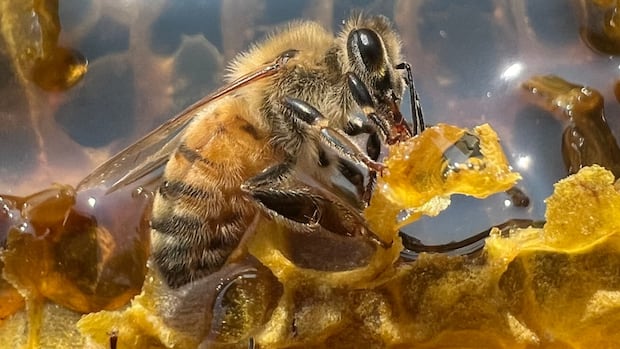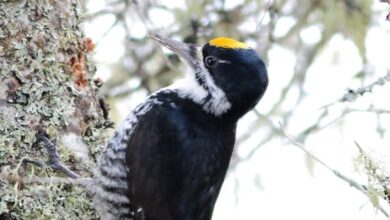Scientists monitor the Outaouais’ bat population to fight back against white-nose syndrome

Many people think of bats as nothing more than unwelcome pests that roost in our attics. But there are scientists working hard in the Outaouais to monitor and preserve the region’s bat population, which has experienced a drastic decline due to a deadly fungal disease.
White-nose syndrome, an infection caused by a fungus known as Pseudogymnoascus destructans, is responsible for the decline of bat populations in caves across North America, including Western Quebec.
The disease was first detected in the Outaouais in 2010 in the Laflèche Cave in Val-de-Monts, Que., said Olivier Cameron Trudel, a biologist with Quebec’s Ministry of the Environment.
The fungal infection affects hibernating bats by contaminating their skin and producing a characteristic fuzzy white fungus on their nose.
Trudel said the infection often causes other irritating lesions on the bat’s skin and dehydration. The changes wrought by the disease lead the bats to wake up more often during the winter hibernation period, burning up the energy and fat they need to survive.
James Pagé, species at risk specialist at the Canadian Wildlife Federation, said the disease has caused population declines of 90 to 95 per cent in bat colonies.
“These hibernation sites are basically decimated by this disease,” Pagé said. “It wakes the bats up during their hibernation, which means they have nothing to eat and drink and eventually many of them just end up dying over the winter.”
For the little brown bat, Pagé said, that impact has been particularly devastating. The bat is classified as an endangered species in Canada.
Monitoring efforts underway in the Outaouais
Efforts are underway in Quebec to track and preserve the province’s bat population.
The province’s Ministry of the Environment has been conducting surveys in mines, caves and other hibernation sites where bats take refuge during the winter, and is also tracking colonies in the summer, said Trudel.
He said the ministry’s research has found preliminary evidence of growing bat populations at some of the Outaouais sites it surveys, but he could not yet quantify the increase.
“We can see some encouraging counts in general but it seems to be a little bit soon to pop the champagne,” he said. “And we still have to hope that all the other regions of the country that are now contaminated will see the same trends that we see in the Outaouais.”

Trudel added it will take decades before bat populations return to their pre-outbreak sizes. The Quebec Network of Acoustic Bat Inventories estimates that more than five million bats have died from white-nose syndrome in the province as of May 2024.
The National Capital Commission (NCC) has its own research project underway to monitor the bat population in Gatineau Park.
Senior biologist Jean-François Gobeil said the NCC has been examining caves and mines in the park to assess potential gathering and hibernation sites.
“Then we can do more specific surveys to see if there are any endangered species using those sites during the winter months, and also to assess what measures we could put in place to protect those sites to help those species,” he said.
The Canadian Wildlife Federation is looking for ways to protect bats that survive the winter and potential white-nose syndrome infections from habitat loss.
Pagé said there’s also research underway to determine how some bats build up resistance to white-nose syndrome, which is then passed on to successive generations.
“The problem is that they only have one pup per year, sometimes two, which means that the population growth is going to be really small as recovery,” he said.
While Gobeil noted bats infected by white-nose syndrome are not commonly detected in Gatineau Park, he said they are still there and there’s no evidence to suggest they’re developing a resistance to the disease.
No cure but prevention possible
There is no cure or treatment for white-nose syndrome. But Trudel said there are actions people can take to protect bats from further population decline.
Trudel said the ministry follows strict decontamination protocols to sterilize the equipment they use during cave visits in order to prevent the spread of the disease. He said those planning cave visits should also be aware of the appropriate decontamination measures and ensure the cave they plan to visit has not had confirmed cases of white-nose syndrome.
It’s also important to protect bats from habitat loss when they’re in our homes, Pagé said. While he understands many people don’t want them living up in their attics, he said it’s best to leave the bats where they are.
Pagé recommends removing bats during the spring or fall months to avoid disrupting the creatures during critical periods when they’re roosting and raising their young. He also suggest people affix bat boxes to their homes so that if removed bats return, they’ll have a suitable habitat.
It might sound unappealing to keep bats around so close to home, but Pagé said people shouldn’t discount how beneficial they are as a predator of nighttime insects like mosquitoes.
“Bats provide millions of dollars in ecosystem services by [preying] on insects that would otherwise attack our crop systems,” he said.
And bat population decline can have impacts on humans and the environment, Pagé warned.
“The effect of this is that we’re going to lose a major predator of insect populations we would otherwise rely on for insect control.”




